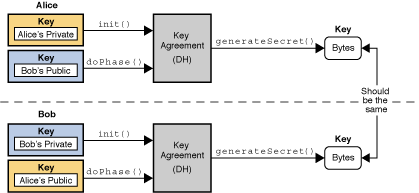这篇文章主要为大家展示了“Java实现常用的三种加密算法是什么”,内容简而易懂,条理清晰,希望能够帮助大家解决疑惑,下面让小编带领大家一起研究并学习一下“Java实现常用的三种加密算法是什么”这篇文章吧。
编程中常见的加密算法有以下几种,它们在不同场景中分别有应用。除信息摘要算法外,其它加密方式都会需要密钥。
信息摘要算法
对称加密算法
非对称加密算法
密钥(key,又常称金钥)是指某个用来完成加密、解密、完整性验证等密码学应用的秘密信息。
加解密中的密钥:对称加密中共享相同的密钥,非对称加密中分公钥和私钥,公钥加密私钥解密。
消息认证码和数字签名中的密钥:在消息认证码中,消息发送方和接收方使用共享密钥进行认证。在数字签名中,签名使用私钥,而验证使用公钥。
会话密钥和主密钥:每次通信只使用一次的密钥称为会话密钥(session key)。相对于会话密钥,重复使用的密钥称为主密钥(master key)。
密码一般是由用户生成,具有可读性,可以记忆和存储,常用于软件管理,而密钥是供实现加密算法的软件使用,不需要具备可读性(不过在编程中为了方便阅读都进行Base64)。我们也可以通过密码来生成密钥。
生成密钥:可以用随机数生成密钥,也可以用口令生成密钥。
配送密钥:可采用事先共享密钥、使用密钥分配中心、使用公钥密码、使用Diffie-Hellman密钥交换。
更新密钥
保存密钥
作废密钥
jdk 中 jce (Java Cryptography Extension) 包含了加密相关的所有API。
生成对称加密算法的密钥

public static SecretKey generateKey(int keySize) {
KeyGenerator keyGenerator;
try {
keyGenerator = KeyGenerator.getInstance("AES");
keyGenerator.init(keySize);
return keyGenerator.generateKey();
} catch (NoSuchAlgorithmException e) {
// ignore
return null;
}
}生成对称非对称加密算法的密钥
/**
* 生成非对称密钥对
*
* @param keySize 密钥大小
* @param random 指定随机来源,默认使用 JCAUtil.getSecureRandom()
* @return 非对称密钥对
* @throws NoSuchAlgorithmException NoSuchAlgorithm
*/
public static PPKeys genKeysRSA(int keySize, SecureRandom random) throws NoSuchAlgorithmException {
KeyPairGenerator generator = KeyPairGenerator.getInstance("RSA");
if (null != random) {
generator.initialize(keySize, random);
} else {
generator.initialize(keySize);
}
KeyPair pair = generator.generateKeyPair();
PPKeys keys = new PPKeys();
PublicKey publicKey = pair.getPublic();
PrivateKey privateKey = pair.getPrivate();
keys.setPublicKey(Base64.getEncoder().encodeToString(publicKey.getEncoded()));
keys.setPrivateKey(Base64.getEncoder().encodeToString(privateKey.getEncoded()));
return keys;
}密钥协商(Diffie-Hellman)
密钥协商是一种协议,两方或多方在通过该协议建立相同的共享密钥,然后通讯内容进行对称加密传输,而不需要交换密钥。
大致过程:每一方生成一个公私钥对并将公钥分发给其它方,当都获得其他方的公钥副本后就可以离线计算共享密钥。
Java中提供了 KeyAgreement 可以实现密钥协商。

Alice 和 Bob 分别用他们的私钥初始化自己的密钥协商对象 KeyAgreement ,调用init() 方法;
然后将通信的每一方的公钥 传入执行 doPhase(Key key, boolean lastPhase) ;
各方生成共享密钥 generateSecret()。
public static void diffieHellman() throws Exception {
AlgorithmParameterGenerator dhParams = AlgorithmParameterGenerator.getInstance("DH");
dhParams.init(1024);
KeyPairGenerator keyGen = KeyPairGenerator.getInstance("DH");
keyGen.initialize(dhParams.generateParameters().getParameterSpec(DHParameterSpec.class), new SecureRandom());
KeyAgreement aliceKeyAgree = KeyAgreement.getInstance("DH");
KeyPair alicePair = keyGen.generateKeyPair();
KeyAgreement bobKeyAgree = KeyAgreement.getInstance("DH");
KeyPair bobPair = keyGen.generateKeyPair();
aliceKeyAgree.init(alicePair.getPrivate());
bobKeyAgree.init(bobPair.getPrivate());
aliceKeyAgree.doPhase(bobPair.getPublic(), true);
bobKeyAgree.doPhase(alicePair.getPublic(), true);
boolean agree = Base64.getEncoder().encodeToString(aliceKeyAgree.generateSecret()).equals(
Base64.getEncoder().encodeToString(bobKeyAgree.generateSecret())
);
System.out.println(agree);
}信息摘要算法又叫加密散列算法,加密过程不需要密钥,常见的加密散列算法有MD系列和SHA系列。
一个理想的加密散列函数应该具备以下特性:
任何信息传入后,输出的总是长度固定;
消息摘要看起来是“随机的”,这样根据原始信息就很难推测出值;
好的散列函数碰撞概率应该极低,也就是不同信息传入后得到相同值的概率;
MD5信息摘要算法(MD5 Message-Digest Algorithm),一种被广泛使用的加密散列函数,输出出一个128位(16字节)的散列值(hash value),MD5最初设计为加密散列函数,而目前发现它存在大量漏洞,所以不建议直接用作加密,不过在非加密场景下如:数据完整性校验,文件完整性校验它仍然有广泛的应用。
public static String md5(String content) {
try {
MessageDigest digest = MessageDigest.getInstance("MD5");
byte[] bytes = digest.digest(content.getBytes(StandardCharsets.UTF_8));
return Hex.encodeHexString(bytes);
} catch (final NoSuchAlgorithmException e) {
throw new IllegalArgumentException(e);
}
}安全散列算法(Secure Hash Algorithm,缩写为SHA)是一个加密散列函数家族,是FIPS(美国联邦信息处理标准)所认证的安全散列算法。能计算出一个数字消息所对应到的,长度固定的字符串(又称消息摘要)的算法。且若输入的消息不同,它们对应到不同字符串的机率很高。
它们分别包含 SHA-0、SHA-1、SHA-2、SHA-3,其中 SHA-0、SHA-1 输出长度是160位,SHA-2 包含 SHA-224、SHA-256、SHA-384、SHA-512、SHA-512/224、SHA-512/256,我们平时常用 SHA-256 。
public static String sha256(String content) {
try {
MessageDigest digest = MessageDigest.getInstance("SHA-256);
byte[] bytes = digest.digest(content.getBytes(StandardCharsets.UTF_8));
return Hex.encodeHexString(bytes);
} catch (final NoSuchAlgorithmException e) {
throw new IllegalArgumentException(e);
}
}对称加密算法,双方持有相同密钥进行加解密,常见的对称加密算法:DES 3DES AES128 AES192 AES256。理解对称加密需要先明白下面几个概念:
分组密码模式:将明文切割进行加密,再将密文拼接到一起。比如AES中会将明文数据切割为大小16字节的数据块,最后一块不够16字节时,使用Padding模式进行补充。
填充(Padding):它有三种模式PKCS5、PKCS7和NOPADDING,PKCS5用缺少的字节数来填充,比如缺少5个字节就填充5个数字5,PKCS7缺少的字节数用0来填充。如果数据刚好是16的整数倍,PKCS5和PKCS7会再补充一个16字节数据来区分填充和有效数据,NOPADDING模式不需要填充。
初始化向量:初始向量IV的作用是使加密更加安全可靠,在分组密码模式下IV大小对应数据块长度。
加密模式:四种加密模式分别是:ECB(电子密码本模式)、CBC(密码分组链接模式)、CFB、OFB。ECB模式是仅仅使用明文和密钥来加密数据,所以该模式下不需要Padding,安全性也较弱,CBC模式数据分块并且使用传入IV依次进行异或操作,安全性也相对较高,所以目前一般都选择CBC模式。
加密密钥:不同加密算法密钥长度不同,比如:DES 默认长度56位,3DES默认长度168位,也支持128位,AES默认128位,也支持192位,256位。我们一般根据密码生成密钥,密码长度需要满足算法密钥长度。
DES 是对称加密算法领域中的典型算法,因为密钥默认长度为56 bit,所以密码长度需要大于 8 byte,DESKeySpec 取前 8 byte 进行密钥制作。
public static String encryptDES(byte[] content, String password) {
try {
SecureRandom random = new SecureRandom();
DESKeySpec desKeySpec = new DESKeySpec(password.getBytes());
SecretKeyFactory secretKeyFactory = SecretKeyFactory.getInstance("DES");
SecretKey secretKey = secretKeyFactory.generateSecret(desKeySpec);
Cipher cipher = Cipher.getInstance("DES");
cipher.init(Cipher.ENCRYPT_MODE, secretKey, random);
return Base64.getEncoder().encodeToString(cipher.doFinal(content));
} catch (Exception e) {
throw new RuntimeException(e);
}
}
public static String decryptDES(String content, String password) throws Exception {
SecureRandom random = new SecureRandom();
DESKeySpec desKeySpec = new DESKeySpec(password.getBytes());
SecretKeyFactory keyFactory = SecretKeyFactory.getInstance("DES");
SecretKey secretKey = keyFactory.generateSecret(desKeySpec);
Cipher cipher = Cipher.getInstance("DES");
cipher.init(Cipher.DECRYPT_MODE, secretKey, random);
return new String(cipher.doFinal(Base64.getDecoder().decode(content)));
}3DES(即Triple DES)。是DES算法的加强,它使用3条56位的密钥对数据进行三次加密。它以DES为基本模块,通过组合分组方法设计出分组加密算法。比起最初的DES,3DES更为安全。密钥默认长度 168 bit, 密码需要大于24 byte,IV 是 8 byte 的随机数字和字母数组。
public static String encrypt3DESECB(String content, String key, String iv) {
try {
IvParameterSpec ivSpec = new IvParameterSpec(iv.getBytes(StandardCharsets.UTF_8));
DESedeKeySpec dks = new DESedeKeySpec(key.getBytes(StandardCharsets.UTF_8));
SecretKeyFactory keyFactory = SecretKeyFactory.getInstance("DESede");
SecretKey secretkey = keyFactory.generateSecret(dks);
Cipher cipher = Cipher.getInstance("DESede/CBC/PKCS5Padding");
cipher.init(Cipher.ENCRYPT_MODE, secretkey, ivSpec);
return Base64.getEncoder().encodeToString(cipher.doFinal(content.getBytes(StandardCharsets.UTF_8)));
} catch (Exception e) {
throw new RuntimeException(e);
}
}
public static String decrypt3DESECB(String content, String key, String iv) {
try {
IvParameterSpec ivSpec = new IvParameterSpec(iv.getBytes(StandardCharsets.UTF_8));
DESedeKeySpec dks = new DESedeKeySpec(key.getBytes(StandardCharsets.UTF_8));
SecretKeyFactory keyFactory = SecretKeyFactory.getInstance("DESede");
SecretKey secretkey = keyFactory.generateSecret(dks);
Cipher cipher = Cipher.getInstance("DESede/CBC/PKCS5Padding");
cipher.init(Cipher.DECRYPT_MODE, secretkey, ivSpec);
return new String(cipher.doFinal(Base64.getDecoder().decode(content)), StandardCharsets.UTF_8);
} catch (Exception e) {
throw new RuntimeException(e);
}
}AES 高级数据加密标准,能够有效抵御已知的针对DES算法的所有攻击,默认密钥长度为128 bit,还可以供选择 192 bit,256 bit。AES-128 AES-192 AES-256
默认 AES-128 ,使用 PBEKeySpec 生成固定大小的密钥。
public static String encryptAES128(String plainText, String password, String salt) throws Exception {
SecretKeyFactory factory = SecretKeyFactory.getInstance("PBKDF2WithHmacSHA1");
byte[] saltBytes = salt.getBytes(StandardCharsets.UTF_8);
// AES-128 密钥长度为128bit
PBEKeySpec spec = new PBEKeySpec(
password.toCharArray(),
saltBytes,
1000,
128
);
SecretKey secretKey = factory.generateSecret(spec);
SecretKeySpec secret = new SecretKeySpec(secretKey.getEncoded(), "AES");
Cipher cipher = Cipher.getInstance("AES/CBC/PKCS5Padding");
AlgorithmParameters params = cipher.getParameters();
IvParameterSpec iv = params.getParameterSpec(IvParameterSpec.class);
cipher.init(Cipher.ENCRYPT_MODE, secret, iv);
byte[] encryptedTextBytes = cipher.doFinal(plainText.getBytes(StandardCharsets.UTF_8));
String encodedText = Base64.getEncoder().encodeToString(encryptedTextBytes);
String encodedIV = Base64.getEncoder().encodeToString(iv.getIV());
String encodedSalt = Base64.getEncoder().encodeToString(saltBytes);
return encodedSalt + "." + encodedIV + "." + encodedText;
}
public static String decryptAES128(String encryptedText, String password) throws Exception {
String[] fields = encryptedText.split("\\.");
byte[] saltBytes = Base64.getDecoder().decode(fields[0]);
byte[] ivBytes = Base64.getDecoder().decode(fields[1]);
byte[] encryptedTextBytes = Base64.getDecoder().decode(fields[2]);
SecretKeyFactory factory = SecretKeyFactory.getInstance("PBKDF2WithHmacSHA1");
PBEKeySpec spec = new PBEKeySpec(
password.toCharArray(),
saltBytes,
1000,
128
);
SecretKey secretKey = factory.generateSecret(spec);
SecretKeySpec secret = new SecretKeySpec(secretKey.getEncoded(), "AES");
Cipher cipher = Cipher.getInstance("AES/CBC/PKCS5Padding");
cipher.init(Cipher.DECRYPT_MODE, secret, new IvParameterSpec(ivBytes));
byte[] decryptedTextBytes;
try {
decryptedTextBytes = cipher.doFinal(encryptedTextBytes);
return new String(decryptedTextBytes);
} catch (IllegalBlockSizeException | BadPaddingException e) {
throw new RuntimeException(e);
}
}使用 AES-256 时可能会出现下面异常:
java.security.InvalidKeyException: Illegal key size
JDK 1.8.0_161 及以上版本默认已经启用无限强度加密:
static {
java.security.Security.setProperty("crypto.policy", "unlimited");
}JDK 1.8.0_161以前版本需要手动安装 jce 策略文件(下载地址)
非对称加密使用一对密钥,公钥用作加密,私钥则用作解密。关于密钥大小,截至2020年,公开已知的最大RSA密钥是破解的是829位的RSA-250,建议至少使用 2048 位密钥。

public static String encrypt(byte[] publicKey, String plainText) {
X509EncodedKeySpec keySpec = new X509EncodedKeySpec(publicKey);
KeyFactory kf;
try {
kf = KeyFactory.getInstance("RSA");
PublicKey publicKeySecret = kf.generatePublic(keySpec);
Cipher cipher = Cipher.getInstance("RSA/ECB/PKCS1Padding");
cipher.init(Cipher.ENCRYPT_MODE, publicKeySecret);
byte[] encryptedBytes = cipher.doFinal(plainText.getBytes());
return new String(Base64.getEncoder().encode(encryptedBytes));
} catch (Exception e) {
log.error("Rsa encrypt error ", e);
throw new RuntimeException(e);
}
}
public static String decrypt(byte[] privateKey, String encryptedText) {
PKCS8EncodedKeySpec keySpec = new PKCS8EncodedKeySpec(privateKey);
KeyFactory kf;
try {
kf = KeyFactory.getInstance("RSA");
PrivateKey privateKeySecret = kf.generatePrivate(keySpec);
Cipher cipher = Cipher.getInstance("RSA/ECB/PKCS1Padding");
cipher.init(Cipher.DECRYPT_MODE, privateKeySecret);
return new String(cipher.doFinal(Base64.getDecoder().decode(encryptedText)), StandardCharsets.UTF_8);
} catch (Exception e) {
log.error("Rsa decrypt error ", e);
throw new RuntimeException(e);
}
}以上是“Java实现常用的三种加密算法是什么”这篇文章的所有内容,感谢各位的阅读!相信大家都有了一定的了解,希望分享的内容对大家有所帮助,如果还想学习更多知识,欢迎关注亿速云行业资讯频道!
免责声明:本站发布的内容(图片、视频和文字)以原创、转载和分享为主,文章观点不代表本网站立场,如果涉及侵权请联系站长邮箱:is@yisu.com进行举报,并提供相关证据,一经查实,将立刻删除涉嫌侵权内容。